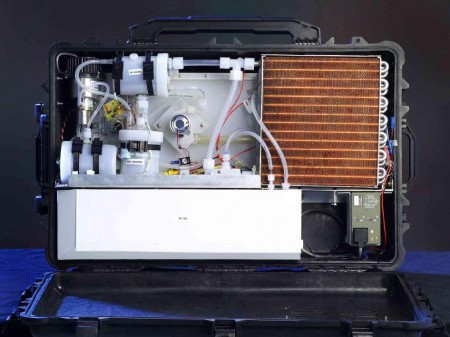Jun
1
This is very good news. A much smaller methanol fuel cell is on the market in Japan, but the JPL fuel cell puts out a worthwhile 300 watts, or 2.5 amps at the customary U.S. 120 volts. That’s enough to run a room’s lights, or a mid range PC, or a fairly good sized LCD TV. Now we’re getting somewhere.
The JPL’s novel fuel cell technology uses liquid methanol as a fuel to produce electrical energy, and does not require any fuel processing. The consumer value in methanol is it’s a simple liquid that doesn’t evaporate off quickly and can be safely handled much like gasoline, except that it’s much harder to ignite. These points cut way down on the accessory kit to the fuel cell for fuel storage and handling. Compared to the complexity of storing gaseous hydrogen, methanol is simple and very cheap. Methanol use can be as simple as putting the nozzle in the tank.
Pure water and carbon dioxide are the only byproducts of the JPL fuel cell, and no pollutants are emitted. Direct Methanol Fuel Cells offer several advantages over other current fuel cell systems, especially with regard to simplicity of design and higher energy density.
Methanol is a very good store of hydrogen with four hydrogen atoms per carbon and oxygen atom in each molecule. It stores in common metal and plastic containers without pressure. If not spilled and ignited, it’s quite safe with existing common sense. It’s a fuel Joe and Jane everyone can cope with without a new learning curve.
JPL Power Technology Program Manager Rao Surampudi in explaining said that USC worked with JPL in the development and advancement of this technology for defense and commercial applications, “JPL invented the Direct Methanol Fuel Cell concept and also made significant contributions to all the facets of the technology. These contributions include: development of advanced catalyst materials, high-performance fuel cell membrane electrode assemblies, compact fuel cell stacks, and system designs.”
Over the years, those applications have expanded from the original defense applications to include such uses as battery chargers for consumer electronics, electric vehicles, stand-alone power systems, and uninterrupted/emergency power supplies. From 1989 to 1998, the Defense Advanced Research Projects Agency (DARPA) funded JPL and USC to develop direct methanol fuel cells for future defense applications. Inventors on the JPL team include Surampudi, Sri. R. Narayanan, Harvey Frank, Thomas Valdez, Andrew Kindler, Eugene Vamos and Gerald Halpert. The USC inventor team includes G.K. Surya Prakash, Marshall Smart and Nobel Laureate George Olah.
Erik Brandon, current Electrochemical Technologies group supervisor at JPL said, “We are looking forward to working closely with the fuel cell industry to further develop this technology to meet future market needs.”
Gerald Halpert, former Electrochemical Technologies group supervisor at JPL believes, “This fuel cell may well become the power source of choice for energy-efficient, non-polluting military and consumer applications.” Pure water and carbon dioxide are the only byproducts of a Direct Methanol Fuel Cell, and no pollutants are emitted.
The press release is not exactly packed with technical data – its rather absent, instead. We’re looking for fuel efficiency, which one would expect to be high, but how high?
The photo about suggests the prototype fits within a briefcase to medium size luggage compartment, which is very good and the photo is of a prototype as well.
In any case, a deal for U.S technology is done at a wattage that is significant using a fuel that most folks could make at home like any moonshiner. Methanol production isn’t quite the task the ethanol presents, nor so choosy about what raw bio materials can be used.
Uprating, downsizing and powering scooters or electric bicycles looks to be an imminent idea. It’s a ways off to powering an automobile, but the attraction seems irresistible. But the U.S. market seed has now been set. When and where can I buy one?
Comments
2 Comments so far



Interesting cell. However I would be a bit more sanguine about the `safety` of methanol. Methanol is not a common household chemical as its poisonous if ingested. Over the years mfrs have found safer substitutes to the point that methanol has been relegated to industrial uses.
But there is an additional danger. If methanol is mixed with another common ingredient, lye (aka drano) it forms a very reactive MEK that is readily absorbed by the skin and can be quite deadly.
From the perspective of the average consumer this is probably not a safe product. In the hands of someone trained in the use of the fuel it would not be a problem. But don’t ever disavow the maximum level of stupidity that can be produced by members of the public.
I guess bleach and ammonia mixing is not so bad considering they haven’t been banned yet. Think about the daily examples of the stupid commoners offing themselves through chlorine poisoning. Oh that’s right, we don’t really hear about that because people some how avoid the limits of their small brains.
Methanol is a great idea, no matter what the self-appointed pundits say.